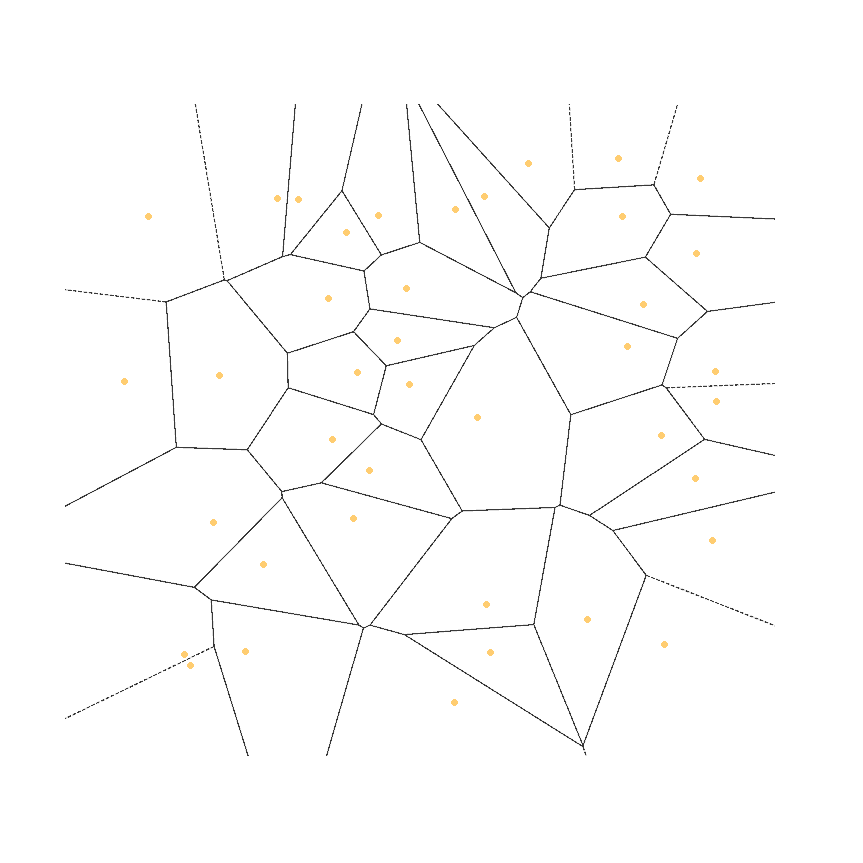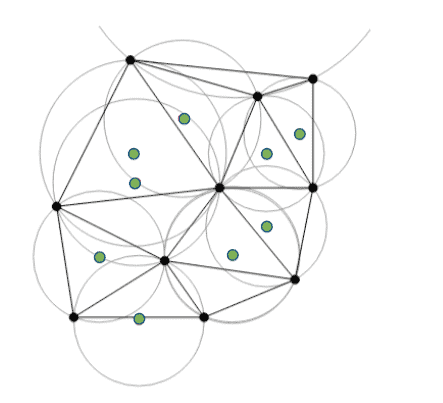1. 引言
在本教程中,我们将介绍 Voronoi 图(Voronoi Diagram)。这是一种在自然界中常见、在科学和工程中也具有广泛应用的数学结构,以俄罗斯数学家 Georgy Voronoi 的名字命名。它也被称为 Voronoi 镶嵌(tessellation)、Voronoi 分解(decomposition)或 Voronoi 分区(partition)。
无论使用哪种称呼,Voronoi 图的视觉特征都非常鲜明,很容易就能识别出来。我们将先通过图形建立直观认识,然后深入其背后的数学原理。
2. 定义
下图展示了在一个二维平面上随机分布的 40 个橙色点,以及它们对应的 Voronoi 图。图中由边界划分出的区域称为 Voronoi 单元(Voronoi Cells):

可以看到,大多数橙色点都位于各自单元的中心位置。但每个单元的边界是根据周围点之间的距离来划分的,黑色线条表示的空间划分是精确的。
更进一步地说,如果我们在某个单元内部加入一个新点,那么这个点离该单元对应的原始点最近。也就是说,周围点越少,这个单元的面积就越大。
用数学语言来表达,可以写成如下形式:
对于给定的一组有限点集合 $ {p_1, p_2, \dots, p_n} $,其中每个点 $ p_k $ 都对应一个 Voronoi 单元 $ R_k $,该单元由平面上所有到 $ p_k $ 的距离小于或等于到其他任何点的距离的点组成。
3. 计算方法
现在我们已经了解了 Voronoi 图的定义,接下来探讨如何计算它。
有很多种算法可以完成这个任务,但最直观的一种方法是:先计算 Delaunay 三角剖分(Delaunay Triangulation),再通过它推导出 Voronoi 图。
3.1 Delaunay 三角剖分是什么?
Delaunay 三角剖分是基于原始点集构建的一组三角形,满足一个关键条件:
任意一个三角形的外接圆中不包含其他三角形的顶点。
举个例子,下图显示了 10 个黑点构成的 Delaunay 三角剖分结构。绿色点表示每个三角形外接圆的圆心:

这些圆心信息对后续生成 Voronoi 图非常关键。
3.2 Voronoi 图与 Delaunay 三角剖分的关系
下图展示了 40 个点的 Voronoi 图(左)与对应的 Delaunay 三角剖分(右)对比:

通过对比可以发现,每个 Delaunay 三角形的外接圆圆心,恰好对应 Voronoi 图中的一个顶点。而 Voronoi 图的边,就是相邻三角形之间圆心连线的结果。
因此,如果我们已经有了 Delaunay 三角剖分的结果,只需要连接相邻三角形的外心,就能得到 Voronoi 图的边。
3.3 如何计算 Delaunay 三角剖分?
一个常用的方法是使用 Bowyer-Watson 算法。该算法通过逐步插入点的方式构建 Delaunay 三角剖分。
算法流程如下:
✅ 算法步骤概述:
- 创建一个包围所有点的“超级三角形”,加入三角形列表。
- 对每个点进行插入操作:
- 遍历所有三角形,找出其外接圆包含当前点的那些三角形。
- 删除这些三角形,形成一个“空腔”。
- 收集空腔边界的边。
- 去除重复的边(即被两个三角形共享的边)。
- 利用这些边和当前点形成新的三角形。
- 最后移除包含超级三角形顶点的三角形。
✅ 伪代码实现:
algorithm BowyerWatson(pointList):
// INPUT
// pointList = 一组需要三角剖分的点
// OUTPUT
// 返回包含 Delaunay 三角剖分结果的三角形列表
创建一个包围所有点的超级三角形
将超级三角形加入三角形列表
for point in pointList:
edgeList = 空集合
for triangle in triangleList:
if point 在 triangle 的外接圆内:
标记 triangle 为无效
将 triangle 的边加入 edgeList
从 triangleList 中移除所有无效三角形
for edge in edgeList:
if edge 被其他三角形共享:
从 edgeList 中移除 edge
for edge in edgeList:
用 edge 和 point 构建新三角形
加入 triangleList
从 triangleList 中移除包含超级三角形顶点的三角形
return triangleList
⚠️ 性能说明:
该算法的复杂度为 $ O(n^2) $,因为每次插入新点时都要遍历所有三角形。但通过优化数据结构(如使用邻接表或哈希表),可以进一步提升性能。
4. 总结
本文通过图形化方式介绍了 Voronoi 图 及其与 Delaunay 三角剖分 的紧密关系。我们解释了如何通过 Delaunay 三角剖分来间接生成 Voronoi 图,并介绍了实现 Delaunay 三角剖分的常用算法 —— Bowyer-Watson 算法。
Voronoi 图在计算机图形学、地图生成、路径规划、模式识别等领域都有广泛应用。掌握其原理和实现方式,对解决实际问题非常有帮助。